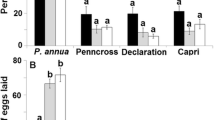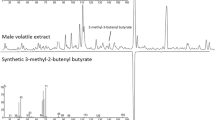Abstract
Beetles in the genus Sphenophorus Schönherr, or billbugs, potentially utilize both volatile and non-volatile behavior-modifying chemical signals. These insects are widely distributed across North America, often occurring in multi-species assemblages in grasses. However, details about their host- and mate-finding behavior are poorly understood. This study tested the hypothesis that volatile organic compounds from host-plants and conspecifics direct the dispersal behavior of hunting billbug S. venatus Say. Further, we characterized the cuticular hydrocarbon profiles of two widespread pest species, S. venatus and bluegrass billbug S. parvulus Gyllenhaal, to assess the potential role of contact pheromones in mate-recognition. In Y-tube olfactometer bioassays, S. venatus males were attracted to a combination of conspecifics and Cynodon dactylon host-plant material, as well as C. dactylon plant material alone. S. venatus females were attracted to a combination of male conspecifics and host-plants but were also attracted to male conspecifics alone. Field evaluation of a putative male-produced aggregation pheromone, 2-methyl-4-octanol, identified from two congeners, S. levis Vaurie and S. incurrens Gyllenhaal, did not support the hypothesis that S. venatus and S. parvulus were also attracted to this compound. Gas chromatography-mass spectrometry analysis of S. venatus and S. parvulus whole-body cuticular extracts indicated a series of hydrocarbons with qualitative and quantitative interspecific variation in addition to intraspecific quantitative variation between males and females. This study provides the first evidence that S. venatus orients toward host- and insect-derived volatile organic compounds and substantiates the presence of species-specific cuticular hydrocarbons that could serve as contact pheromones for sympatric Sphenophorus species.



Similar content being viewed by others
References
Alm SR, Villani MG, Roelofs W (1999) Oriental beetles (Coleoptera: Scarabaeidae): current distribution in the United States and optimization of monitoring traps. J Econ Entomol 92:931–935
Aoyagi M, Ishii M, Hirowatari T, Yasuda T (1990) Record of the zoysiagrass billbug, Sphenophorus venatus vestitus Chittenden, from the bank of the Yamato River in Osaka and Nara prefectures. J Appl Entomol Z 34:253–254
Baker JE, Woo SM, Nelson DR, Fatland CL (1984) Olefins as major components of epicuticular lipids of three Sitophilus weevils. Comp Biochem Physiol (4):877–884
Dell Inc. (2015) Dell Statistica (data analysis software system), version 13. soft-ware.dell.com
Duffy AG, Powell GS, Zaspel JM, Richmond DR (2018) Billbug (Coleoptera: Dryophthoridae: Sphenophorus) seasonal biology and DNA-based life stage association in Indiana turfgrass. J Econ Entomol 111:304–313
Dupuy MM, Ramirez RA (2016) Biology and management of billbugs (Coleoptera: Curculionidae) in turfgrass. J Int Pest Man 7:1–10
Eliyahu D, Nojima S, Capracotta SS, Comins DL, Schal C (2008) Identification of cuticular lipids eliciting interspecific courtship in the German cockroach, Blattella germanica. Naturwissenschaften 95:403–412
Francke W, Dettner K (2005) Chemical signaling in beetles. Top Curr Chem 240:85–166
Giblin–Davis RM, Oehlschlager AC, Perez A, Gries G, Gries R, Weissling TJ, Chinchilla CN, Peña JE, Hallett RH, Pierce HD Jr, Gonzalez LM (1996) Chemical and behavioral ecology of palm weevils (Curculionidae: Rhynchophorinae). Fla Entomol 79:153–167
Giblin–Davis RM, Gries R, Crespi B, Robertson LN, Hara AH, Gries G, O' Brien CW, Pierce HD Jr (2000) Aggregation pheromones of two geographical isolates of the new Guinea sugarcane weevil, Rhabdoscelus obscurus. J Chem Ecol 26:2673–2678
Ginzel MD, Blomquist GJ (2016) Insect hydrocarbons: biochemistry and chemical ecology. In: Cohen E (ed) Extracellular composite matrices in arthropods. Spring, New York
Ginzel MD, Blomquist GJ, Millar JG, Hanks LM (2003) Role of contact pheromones in mate recognition in Xylotrechus colonus. J Chem Ecol 29:533–545
Goldson SL, Barratt BIP, Armstrong KF (2016) Invertebrate biosecurity challenges in high-productivity grassland: The New Zealand example. Front Plant Sci. 7:1670
Guarina S, De Pasquale C, Peri E, Alonzo G, Colazza S (2008) Roles of volatile and contact pheromones in the mating behavior of Bagrada hilaris (Heteroptera: Pentatomidae). Eur J Entomol 105:613–617
Hong K, Lee J, Lee G, Lee S (2012) The status quo of invasive alien insect species and plant quarantine in Korea. J Asia Pac Entomol 15:521–532
Howard RW, Blomquist GJ (2005) Ecological, behavioral, and biochemical aspects of insect hydrocarbons. Annu Rev Entomol 50:371–393
Huang TI, Buss EA (2009) Billbug (Coleoptera: Curculionidae) species composition, abundance, seasonal activity, and developmental time in Florida. J Econ Entomol 102:309–314
Illescas-Riquelme CP, Llanderal-Cázares CC, Ruiz-Montiel C, González-Hernández H, Alatorre-Rosas R, Cruz-López L, Rojas JC (2016) Evidence for male-produced aggregation pheromone in Sphenophorus incurrens (Coleoptera: Curculionidae). Fla Entomol 99:522–527
Johnson-Cicalese JM, Wolfe GW, Funk CR (1990) Biology, distribution, and taxonomy of billbug turf pest (Coleoptera: Curculionidae). Environ Entomol 19:1037–1046
Landolt PJ (1997) Sex attractant and aggregation pheromones of male phytophagous insects. Am Entomol 43(1):12–22
Lapointe SL, Hunter WB, Alessandro RT (2004) Cuticular hydrocarbons on elytra of the diaprepes root weevil Diaprepes abbreviatus (L.) (Coleoptera: Curculionidae). Agric For Entomol 6:251–257
León-García I, Rodríguez-Leyva E, Equihua-Martínez A, Valdez JM (2012) First record of the billbug, Sphenophorus venatus (say) (Coleoptera: Curculionidae: Dryophthorinae), on turfgrass in Quintana Roo, Mexico. Coleopt Bull 66:34–36
Martins CBC, Saad EB, de Almeida LM, Zarbin PHG (2013) Cuticular compounds recognition and mating behavior of the rice water weevil Oryzophagus oryzae (Coleoptera, Curculionidae). J Insect Behav 26:812–823
McGraw BA, Rodriguez-Saona C, Holdcraft R, Szendrei Z, Koppenhöfer AM (2011) Behavioral and electrophysiological responses of Listronotus maculicollis (Coleoptera: Curculionidae) to volatiles from intact and mechanically damaged annual bluegrass. Environ Entomol 40:412–419
Morimoto N, Kiritani K (1995) Fauna of exotic insects in Japan. Bull Nat Inst Agro-Environ Sci 12:87–120
Mutis A, Parra L, Palma R, Pardo F, Perich F, Quiroz A (2009) Evidence of contact pheromone use in mating behavior of the raspberry weevil (Coleoptera: Curculionidae). Environ Entomol 38:192–197
Ordaz-González EL, Equihua-Martínez A, León-García I, Jones RW, Aragón A, Hernández RH, Vergara Pineda S (2014) Species of Sphenophorus (Coleoptera: Dryophthoridae) associated with golf courses in Mexico. Fla Entomol 97:857–860
Pomonis J, Hakk H (1984) Alkanes from surface lipids of sunflower stem weevil, Cylindrocopturus adspersus (LeConte). J Chem Ecol 10:1335–1347
Potter DA, Haynes KF (1993) Field testing pheromone traps for predicting masked chafer (Coleoptera: Scarabaeidae) grub density in golf course turf and home lawns. J Entomol Sci 28:205–212
Ramirez-Lucas P, Malosse C, Ducrot P, Lettere M, Zagatti P (1996) Chemical identification, electrophysiological and behavioral activities of the pheromone of Metamsius hemipterus (Coleoptera: Curculionidae). Bioorgan Med Chem 4:323–330
Reddy G, Guerrero A (2004) Interactions of insect pheromones and plant semiochemicals. Trends Plant Sci 9:253–261
Robbins PS, Alm SR, Armstrong AL, Averill AL, Baker TC (2009) Trapping Phyllophaga spp. (Coleoptera: Scarabaeidae: Melolonthinae) in the United States and Canada using sex attractants. J Insect Sci 6:39
Ruiz-Montiel C, Gonzalez-Hernandez H, Leyva J, Llanderal-Cazares D, Cruz-Lopez L, Rojas JC (2003) Evidence for a male-produced aggregation pheromone in Scyphophorus acupunctatus Gyllenhaal (Coleoptera: Curculionidae). J Econ Entomol 96:1126–1131
Ruiz-Montiel C, García-Coapio G, Rojas JC, Malo EA, Cruz-López L, Real ID, González-Hernández H (2008) Aggregation pheromone of the agave weevil Scyphophorus acupunctatus. Entomol Exp Appl 127:207–217
Schmuff NR, Phillips JK, Burkholder WE, Falls HM, Chen CW, Roller PP, Ma M (1984) The chemical identification of the rice weevil and maize weevil aggregation pheromone. Tetrahedron Lett 25:1533–1534
Szendrei Z, Rodriguez-Saona CR (2010) A meta-analysis of behavioral manipulation of insect pests with plant volatiles. Entomol Exp Appl 134:201–210
Szendrei Z, Malo E, Stelinski L, Rodriguez-Saona CR (2009) Response of cranberry weevil (Coleoptera: Curculionidae) to host plant volatiles. Environ Entomol 38:861–869
Thomas ML (2011) Detection of female mating status using chemical signals and cues. Biol Rev 86:1–13
Thornhill R, Alcock J (1983) The evolution of insect mating systems. Harvard University Press, Cambridge, Massachusetts
Vaurie P (1951) Revision of the genus Calendra (formerly Sphenophorus) in the United States and Mexico (Coleoptera: Curculionidae). B Am Mus Nat Hist 93:33–186
Vittum P, Villani M, Tashiro H (1999) Turfgrass insects of the United States and Canada. Cornell University Press, Ithaca, NY
Yang SW, Shim GY, Kim JH, Hong KJ, Jeong YG (2009) Exotic pest, hunting billbug, Sphenophorus venatus vestitus Chittenden (Coleoptera, Dryophthoridae) in Korea. Kor Turfgrass Sci 23:265–270
Yoshida M, Nabeshima H (1981) Invasion of the turfgrass injuring insects, the hunting billbug (Sphenophorus species) in Japan [from the United States of America]. Journal of Japan Turfgrass Research Association 10:57–61
Young FB (2002) Seasonal activity and biology of the hunting billbug, Sphenophorus venatus vestitus (Coleoptera: Curculionidae) in northwest Arkansas. M.S. thesis, 383 University of Arkansas, Fayetteville
Zarbin PHG, Arrigoni E, Reckziegel A, Moreira J, Baraldi P, Vieira P (2003) Identification of male-specific chiral compound from the sugarcane weevil Sphenophorus levis. J Chem Ecol 29:377–386
Acknowledgements
We thank Danielle Craig, Matthew Ethington, and Garrett Price for field and laboratory assistance. We are grateful for the cooperation of Dr. Ian Kaplan’s lab group, especially Ulianova Vidal Gómez, while conducting the olfactometry bioassays. Brad Coole and Jeff Sexton (Rolling Hills Country Club), Brian Bornino (Purdue Sports Turf), and Glenn Hardebeck and Aaron Kreider (William H. Daniel Turfgrass Research and Diagnostic Center) provided insect collecting sites. We appreciate Dr. Paulo Henrique G. Zarbin (Universidade Federal do Paraná) for providing the synthetic pheromone lure. We thank Dr. Gary Blomquist (Department of Biochemistry and Molecular Biology, University of Nevada, Reno) for assisting with the identification of cuticular hydrocarbons. Lastly, we thank Dr. Gary Felton, Dr. David Robert Hall, Dr. Ben McGraw, and one anonymous reviewer for their helpful suggestions that improved the quality of this manuscript. This research was conducted in partial fulfillment of a M.Sc. degree for A.G. Duffy from Purdue University and funding was provided by the United States Golf Association (2015-10-525).
Author information
Authors and Affiliations
Corresponding author
Electronic supplementary material
Online Resource 1
(DOCX 23 kb)
Online Resource 2
(DOCX 19 kb)
Rights and permissions
About this article
Cite this article
Duffy, A.G., Hughes, G.P., Ginzel, M.D. et al. Volatile and Contact Chemical Cues Associated with Host and Mate Recognition Behavior of Sphenophorus venatus and Sphenophorus parvulus (Coleoptera: Dryophthoridae). J Chem Ecol 44, 556–564 (2018). https://doi.org/10.1007/s10886-018-0967-8
Received:
Revised:
Accepted:
Published:
Issue Date:
DOI: https://doi.org/10.1007/s10886-018-0967-8




